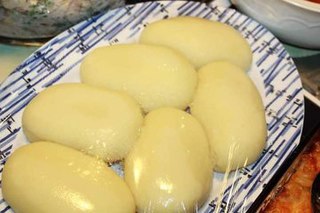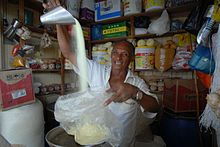
Flour is a powder made by grinding raw grains, roots, beans, nuts, or seeds. Flours are used to make many different foods. Cereal flour, particularly wheat flour, is the main ingredient of bread, which is a staple food for many cultures. Corn flour has been important in Mesoamerican cuisine since ancient times and remains a staple in the Americas. Rye flour is a constituent of bread in central and northern Europe.

Manihot esculenta, commonly called cassava, manioc, or yuca, is a woody shrub of the spurge family, Euphorbiaceae, native to South America, from Brazil and parts of the Andes. Although a perennial plant, cassava is extensively cultivated as an annual crop in tropical and subtropical regions for its edible starchy root tuber, a major source of carbohydrates. Though it is often called yuca in parts of Spanish America and in the United States, it is not related to yucca, a shrub in the family Asparagaceae. Cassava is predominantly consumed in boiled form, but substantial quantities are used to extract cassava starch, called tapioca, which is used for food, animal feed, and industrial purposes. The Brazilian farinha, and the related garri of West Africa, is an edible coarse flour obtained by grating cassava roots, pressing moisture off the obtained grated pulp, and finally drying it.

Tapioca is a starch extracted from the storage roots of the cassava plant, a species native to the North and Northeast regions of Brazil, but whose use is now spread throughout South America. It is a perennial shrub adapted to the hot conditions of tropical lowlands. Cassava copes better with poor soils than many other food plants.

Brazilian cuisine is the set of cooking practices and traditions of Brazil, and is characterized by European, Amerindian, African, and Asian influences. It varies greatly by region, reflecting the country's mix of native and immigrant populations, and its continental size as well. This has created a national cuisine marked by the preservation of regional differences..

A pancake is a flat cake, often thin and round, prepared from a starch-based batter that may contain eggs, milk and butter and cooked on a hot surface such as a griddle or frying pan, often frying with oil or butter. It is a type of batter bread. Archaeological evidence suggests that pancakes were probably eaten in prehistoric societies.
Indian cuisine consists of a variety of regional and traditional cuisines native to India. Given the diversity in soil, climate, culture, ethnic groups, and occupations, these cuisines vary substantially and use locally available spices, herbs, vegetables, and fruits.
Malaysian cuisine consists of cooking traditions and practices found in Malaysia, and reflects the multi-ethnic makeup of its population. The vast majority of Malaysia's population can roughly be divided among three major ethnic groups: Malays, Chinese and Indians. The remainder consists of the indigenous peoples of Sabah and Sarawak in East Malaysia, the Orang Asli of Peninsular Malaysia, the Peranakan and Eurasian creole communities, as well as a significant number of foreign workers and expatriates.

Cambodian cuisine is an umbrella term for the cuisines of all ethnic groups in Cambodia, whereas Khmer cuisine refers specifically to the more than thousand years old culinary tradition of the Khmer people. Over centuries, Cambodian cuisine has incorporated elements of Indian, Chinese and more recently French cuisine, and due to some of these shared influences and mutual interaction, it has many similarities with the neighbouring Thai, Vietnamese and Lao cuisines.

Fufu is a pounded meal found in West African cuisine. It is a Twi word that originates from the Akans in Ghana. The word, however, has been expanded to include several variations of the pounded meal found in other African countries including Sierra Leone, Guinea, Liberia, Cote D'Ivoire, Benin, Togo, Nigeria, Cameroon, the Democratic Republic of Congo, the Central African Republic, the Republic of Congo, Angola and Gabon.

The yacón is a species of perennial daisy traditionally grown in the northern and central Andes from Colombia to northern Argentina for its crisp, sweet-tasting, tuberous roots. Their texture and flavour are very similar to jícama, mainly differing in that yacón has some slightly sweet, resinous, and floral undertones to its flavour, probably due to the presence of inulin, which produces the sweet taste of the roots of elecampane, as well. Another name for yacón is Peruvian ground apple, possibly from the French name of potato, pomme de terre. The tuber is composed mostly of water and fructooligosaccharide.

Filipino cuisine is composed of the cuisines of more than a hundred distinct ethnolinguistic groups found throughout the Philippine archipelago. A majority of mainstream Filipino dishes that compose Filipino cuisine are from the food traditions of various ethnolinguistic groups and tribes of the archipelago, including the Ilocano, Pangasinan, Kapampangan, Tagalog, Bicolano, Visayan, Chavacano and Maranao ethnolinguistic groups. The dishes associated with these groups evolved over the centuries from a largely indigenous base shared with maritime Southeast Asia with varied influences from Chinese, Spanish and American cuisines, in line with the major waves of influence that had enriched the cultures of the archipelago and adapted using indigenous ingredients to meet local preferences.

A flatbread is a bread made with flour; water, milk, yogurt, or other liquid; and salt, and then thoroughly rolled into flattened dough. Many flatbreads are unleavened, although some are leavened, such as pizza and pita bread.

Indigenous cuisine of the Americas includes all cuisines and food practices of the Indigenous peoples of the Americas. Contemporary Native peoples retain a varied culture of traditional foods, along with the addition of some post-contact foods that have become customary and even iconic of present-day Indigenous American social gatherings. Foods like cornbread, turkey, cranberry, blueberry, hominy and mush have been adopted into the cuisine of the broader United States population from Native American cultures.

Nigerian cuisine consists of dishes or food items from the hundreds of ethnic groups that comprise Nigeria. Like other West African cuisines, it uses spices and herbs with palm or groundnut oil to create deeply flavored sauces and soups.

A great variety of cassava-based dishes are consumed in the regions where cassava is cultivated, and the ingredient is included many national or ethnic specialities.

Vegetable chips are chips (crisps) that are prepared using vegetables other than potatoes. Vegetable chips may be fried, deep-fried, dehydrated, dried or baked. Many different root vegetables or leaf vegetables may be used. Vegetable chips may be eaten as a snack food, and may accompany other foods such as dips, or be used as a topping on dishes. In the United States, vegetable chips are often mass-produced, with many brands marketed to consumers.

Cooking the potato, a tuber that has been consumed for more than 8,000 years, only really developed after the 16th century, and took nearly three centuries to become established in certain regions. In the 20th century, this type of cooking was practiced on all continents, as the potato, a source of carbohydrates, proteins and vitamin C, was easy to grow and became one of the staple foods of mankind; the method of preparation, however, can modify its nutritional value.




















